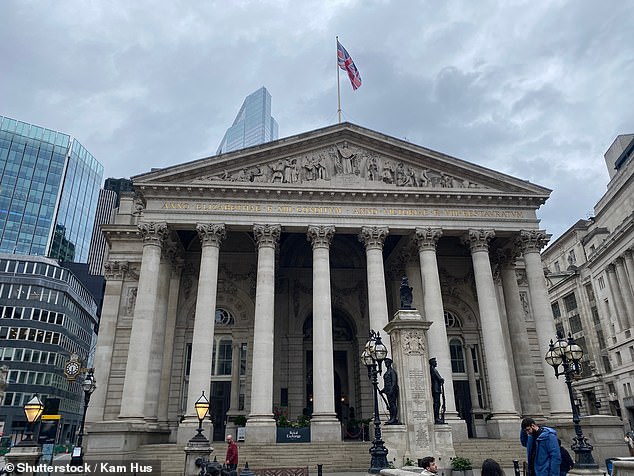House prices rose 2.9% from a year ago, but interest rate concerns could dampen future growth
According to the latest figures from the Office for National Statistics, the average house price rose by 2.9 percent in the 12 months to September.
The typical house now sells for £292,000; an increase from the annual reading of 2.7 percent as of August.
However, on a monthly basis, house prices fell by 0.3 percent, reflecting the usual seasonal slowdown in the run-up to Christmas.
Rising annual house price growth is believed to be the result of falling mortgage rates in recent months, but concerns about higher inflation and a return to rising interest rates could dampen future growth, experts say.
The ONS figures are lagged compared to other house price indexes, but are considered more accurate because they are based on completed sales.
In September, mortgage rates fell to lows not seen before the Liz Truss mini-Budget at the end of 2022, sending markets reeling.
The lowest five-year fix reached 3.68 percent, while the lowest two-year fix fell to 3.82 percent – although these averages have risen again recently.
Upward trend: The typical UK house price rose by 2.9% in the year to September
Emily Williams, research director at property agent Savills, said: ‘Growth in September was driven by the easing of mortgage rates.
‘We expect this growth pattern to continue in the coming years. Despite some recent rises in mortgage rates, debt is cheaper than at the start of the year, and the Bank of England is likely to make further cuts to its base rate next year.”
Where have house prices risen the most?
The pace of house price growth varies across Britain.
According to the ONS, prices in Wales have risen by just 0.4 percent in the past year.
Meanwhile, in Scotland, prices rose by 5.7 per cent in the 12 months to September, and in Northern Ireland the average house rose by 6.2 per cent.
Prices across England have risen an average of 2.5 per cent – £8,000 higher than a year ago. However, a north-south divide remains.
Prices in the Northeast have increased by an average of 6.5 percent on an annual basis. Whole prices in the North West and Yorkshire and the Humber rose by 4.8 per cent and 4.4 per cent respectively.
At the other end of the spectrum, average prices in London are down 0.5 percent compared to a year ago. In the east of England, average house prices have risen by 1.2 per cent and in the south west, prices have risen by just 1 per cent.
What next for house prices?
It is difficult to predict what will happen to house prices and where in the country values will rise the most.
Savills predicts that the average house price will rise by 23.4 percent over the next five years, and expects the north to see the most growth.
Meanwhile, Hamptons predicts that average prices will rise by an average of 12.5 percent in the four years between early 2024 and the end of 2027. Hamptons expects prices in the south to rise even further in the future.
Potential obstacles to house price growth have emerged in recent weeks. Mortgage rates have risen and the Bank of England is now likely to cut rates more slowly than previously expected.
Rachel Reeves’ budget is being interpreted by the markets as inflationary, which has further reinforced the feeling that interest rates will stay higher for longer.
Today the ONS also announced that inflation rose to 2.3 percent in the 12 months to September, essentially sinking hopes of a Bank of England rate cut next month.
In addition, the Chancellor increased the stamp duty surcharge for second home buyers from 3 percent to 5 percent. This is in addition to the rates that normal movers already pay.
Many real estate professionals believe this will deter many landlords, small developers and second home buyers from purchasing property. And when there are fewer buyers in the market, prices are more likely to fall.

The increase in inflation announced today, from 1.7 percent in September to 2.3 percent in October, has dashed hopes for a new interest rate cut by the Bank of England (file image)
North London estate agent Jeremy Leaf said: ‘Although the ONS provides the most comprehensive of all price surveys as it covers cash and mortgage transactions, it reflects the decision-making of buyers and sellers from at least a few months ago.
“Since then we have had to deal with concerns about the budget and its implications.
‘The result has been more caution and tougher negotiations on available properties, despite the recent decline in mortgage rates.
“Concerns remain about the pace of further rate cuts and increases in inflation, as buyers want to ensure they have sufficient cushion against potentially rising costs.”
Rachael Hunnisett, director of lender April Mortgages, added: “The tide appears to be turning.
‘Mortgage rates are rising again and inflation has now climbed back above the Bank of England’s 2 percent target, casting doubt on the strength of the housing market recovery.
‘If interest rates fall slowly over the coming months, we could see house price increases weaken as homebuyers become more cautious and demand falls.’
Some links in this article may be affiliate links. If you click on it, we may earn a small commission. That helps us fund This Is Money and keep it free to use. We do not write articles to promote products. We do not allow a commercial relationship to compromise our editorial independence.
